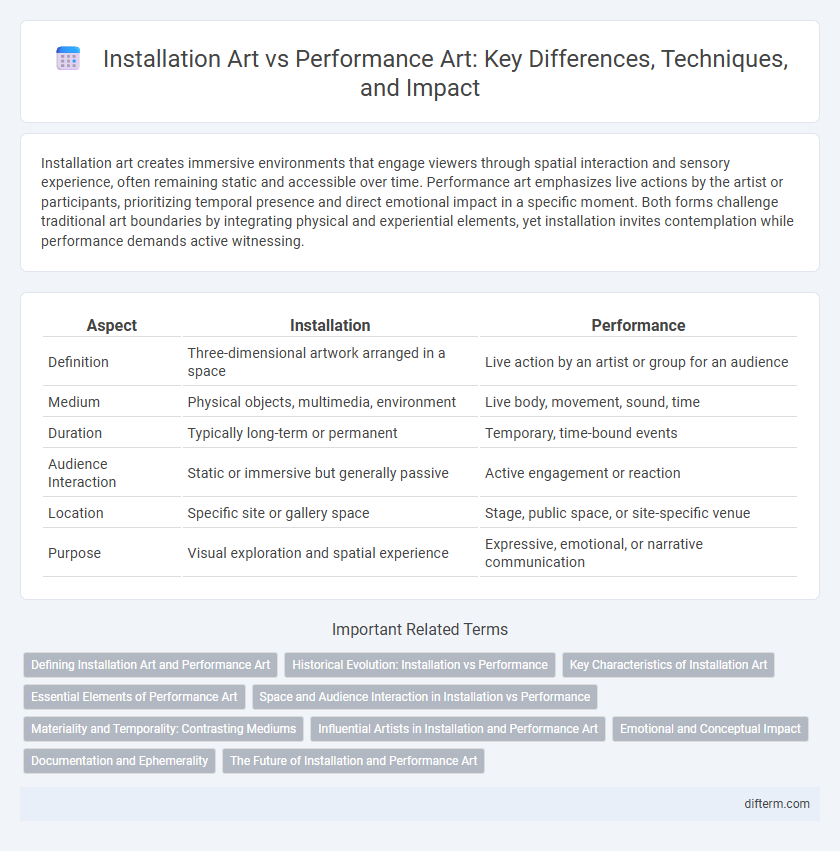Installation art creates immersive environments that engage viewers through spatial interaction and sensory experience, often remaining static and accessible over time. Performance art emphasizes live actions by the artist or participants, prioritizing temporal presence and direct emotional impact in a specific moment. Both forms challenge traditional art boundaries by integrating physical and experiential elements, yet installation invites contemplation while performance demands active witnessing.
Table of Comparison
| Aspect | Installation | Performance |
|---|---|---|
| Definition | Three-dimensional artwork arranged in a space | Live action by an artist or group for an audience |
| Medium | Physical objects, multimedia, environment | Live body, movement, sound, time |
| Duration | Typically long-term or permanent | Temporary, time-bound events |
| Audience Interaction | Static or immersive but generally passive | Active engagement or reaction |
| Location | Specific site or gallery space | Stage, public space, or site-specific venue |
| Purpose | Visual exploration and spatial experience | Expressive, emotional, or narrative communication |
Defining Installation Art and Performance Art
Installation art transforms spaces into immersive environments using materials and multimedia, encouraging viewer interaction and altering perception. Performance art centers on live actions executed by the artist or participants, emphasizing temporality and the body as the medium. Both forms challenge traditional boundaries by prioritizing experience over static objects, yet installation art remains spatial while performance art unfolds through time.
Historical Evolution: Installation vs Performance
Installation art emerged in the early 20th century, evolving from traditional sculpture to immersive environments that engage viewers spatially and sensorially. Performance art developed simultaneously, rooted in Dada and Futurism, emphasizing live actions and temporal experiences that challenge conventional art forms. The historical evolution highlights a shift from static objects to experiential practices, reflecting changing artist intentions and audience interactions.
Key Characteristics of Installation Art
Installation art transforms space by integrating materials, objects, and environment into a cohesive experience that engages multiple senses. Unlike performance art, installation art remains static and accessible over time, encouraging prolonged interaction and contemplation. Key characteristics include spatial immersion, viewer participation, and a focus on contextual and environmental elements.
Essential Elements of Performance Art
Performance art centers on time, space, the performer's physical presence, and the audience's interaction, creating a dynamic, ephemeral experience distinct from static installations. Essential elements include live action, immediacy, and often improvisation, emphasizing vulnerability and direct communication between artist and spectators. This art form challenges traditional boundaries by integrating body, environment, and temporal flow into a cohesive artistic expression.
Space and Audience Interaction in Installation vs Performance
Installation art transforms physical space into immersive environments, inviting viewers to explore and interact freely, often encouraging personal interpretation. Performance art relies on temporal presence and dynamic interaction between artist and audience, where the shared space becomes a live, evolving experience. Spatial boundaries in installation are fixed and physical, while performance emphasizes fluid, participatory interactions within a defined timeframe.
Materiality and Temporality: Contrasting Mediums
Installation art emphasizes materiality through the use of physical objects and spatial environments that engage multiple senses and persist over time, creating a tangible, immersive experience. Performance art prioritizes temporality, existing as a live, time-bound enactment where the artist's body and actions become the medium, emphasizing ephemerality and process over permanence. The contrast between installation and performance lies in their engagement with space and time: installations embody material presence, while performances highlight transient, momentary experience.
Influential Artists in Installation and Performance Art
Influential artists in installation art include Yayoi Kusama, whose immersive environments redefine spatial experience, and James Turrell, known for manipulating light and perception. Performance art pioneers like Marina Abramovic challenge audience interaction and endurance, while Joseph Beuys integrates activism and ritual in his works. Both disciplines emphasize experiential engagement but differ in medium and temporal structure, shaping contemporary art discourse.
Emotional and Conceptual Impact
Installation art creates immersive environments that evoke deep emotional responses by engaging viewers' senses and encouraging prolonged reflection. Performance art delivers a live, immediate emotional connection through physical presence and real-time interaction, emphasizing the transient nature of experience. Both forms challenge traditional art boundaries, fostering conceptual exploration by prompting viewers to reconsider space, time, and human experience.
Documentation and Ephemerality
Installation art relies heavily on thorough documentation such as photographs, videos, and written records to preserve its often site-specific and temporal nature. Performance art's ephemerality challenges documentation efforts, as the live experience, audience interaction, and fleeting gestures are difficult to fully capture or replicate. Effective archiving strategies and multimedia recordings become essential for preserving both installation and performance art's transient qualities and ensuring their continued accessibility for future analysis and appreciation.
The Future of Installation and Performance Art
Installation art transforms spaces into immersive environments that engage multiple senses, creating a physical and conceptual experience. Performance art incorporates live actions and audience interaction, emphasizing temporality and presence in the moment. The future of both mediums lies in hybrid forms that combine digital technology, augmented reality, and interactive elements to blur boundaries between artist, artwork, and audience.
installation vs performance Infographic

 difterm.com
difterm.com